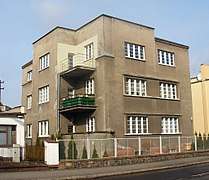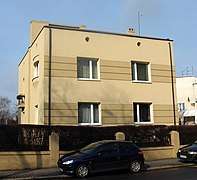Ossoliński Alley in Bydgoszcz
Ossoliński Alley is a large dual carriageway road located in downtown Bydgoszcz.
| Bydgoszcz | |
|---|---|
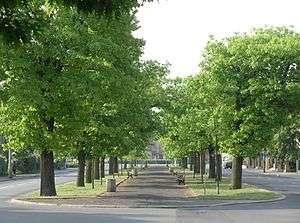 View of the street | |
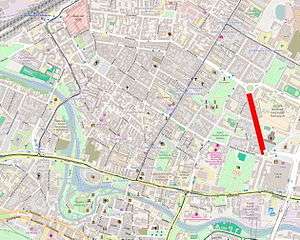 Location of Ossoliński Alley | |
| Native name | Polish: Aleja Ossolińskich w Bydgoszczy |
| Part of | Bydgoszcz Old town district |
| Namesake | House of Ossoliński |
| Owner | City of Bydgoszcz |
| Length | 500 m (1,600 ft) |
| Location | Bydgoszcz |
Location
The avenue is located in the eastern part of the downtown Bydgoszcz and links J. Weyssenhoff Square with Ossoliński roundabout.
Naming
Through history, this street had the following names:[1]
- From 1906 to 1920, Hohenzollernstrasse;
- From 1920 to 1939, Ossoliński Alley;
- From 1939 to 1945, Johann Herder Allee;
- Since 1945, Ossoliński Alley
The namesake of the street comes from is among the House of Ossoliński, associated with Bydgoszcz in the 17th century with in particular Jerzy Ossoliński (1633-1645, 1648-1650) and his son Francis (1645-1648), Starosts of Bydgoszcz and Crown Chancellor .
History
Ossoliński Alley has been laid out in 1903, in the same conditions of urban development as Adam Mickiewicz Alley in the eastern area of Gdańska Street called "Hempelscher Felde":[2] this plot was bought in the 1890s by the municipality to develop its urban plans based on a garden city concept developed by Hermann Stübben.[3]
This axis was a dual carriageway avenue lined up with trees, called Hohenzolernstrasse in its south part, Bülowstrasse in it north part (in 1920 it became part of Adam Mickiewicz alley). The construction of the avenue has been completed in 1903; this was then the widest street in the city: 40 m wide, it had two carriageways, and in a pedestrian walkway in the middle with lawn and trees (red oaks with festoons of Virginia creepers.[4] Street inception was in direct relationship with the erection in 1902 of buildings for the Kaiser Wilhelm's first university and scientific institution in Bydgoszcz (German: Kaiser "Wilhelm's Institut für Landwirtschaft zu Bromberg").[2] The institute architectural ensemble has been erected on the eastern side of the street between 1903 and 1906. By contrast, the area on the western side of the alley has been planned and designed in 1912 by German architect Josef Stübben. However, most of the villas in this district ("Sielanka" or Idyll) have been essentially erected during interwar period.[5]
In 1924, the south-western tip of Ossoliński Alley has been identified to accommodate the construction of St. Vincent de Paul's Basilica, the largest religious edifice in Bydgoszcz, and one of the largest in Poland. The whole complex has only been completed in 2003.[6]
In the 1950s, an urbanization project designed and created in Bydgoszcz two "clone" avenues of Ossoliński alley with two lanes, middle tree planted sidewalk: 11 November street (Leśne district) and Stanisław Noakowski street (Kapuściska district).

Green
The alley has two rows of red oaks planted at the beginning of the 20th centurytwentieth century. Four of them are listed as Polish monuments of nature:[7]
- Three Magnolias at No.12;
- One horse-chestnut at No.3.
Karol Szymanowski alley, crossing the southern part of Ossoliński avenue is unique by the presence of a monumental perspective of 46 specimens of Swedish whitebeams, all listed as Polish monuments of nature.[7]
Main places and buildings
St. Vincent de Paul's Basilica, Ossoliński Alley No.2
Registered on Kuyavian-Pomeranian Voivodeship heritage list, No.601231, Reg. A/846/1-2, May 30, 1996.[8]
1925-1939, by Adam Ballenstedt
The basilica, completed in 1945, has been designed by Polish architect Adam Ballenstedt and comprises the church, a monastery and a park. Minor Basilica dedication has been carried out during a ceremony chaired by Pope John Paul II, on June 3, 1997[9]
 General view
General view Doors of Blessings
Doors of Blessings Nave view
Nave view Inside dome
Inside dome
Buildings of the Institute of Agriculture
Registered on Kuyavian-Pomeranian Voivodeship heritage list, No.601253, Reg. A/676/1-8, May 20, 1992[8]
1903-1906, by H. Delius
The architectural ensemble of the Institutes of Agriculture in Bydgoszcz occupies an area of 7.5 hectares, between J. Weyssenhoff Square, Ossolińsky Alley, Powstańców Wielkopolskich Alley and Karol Szymanowski Street. The western area is laid out with buildings, the eastern one is a 5 ha zone of field vegetation, with livestock, greenhouses and a barn.[10]
 Main facade of No.4/6
Main facade of No.4/6 Detail of No.4
Detail of No.4 View of No.6 on foreground
View of No.6 on foreground Detail of half-timbered elements
Detail of half-timbered elements Facade of No.8/10
Facade of No.8/10 Side view of No.8/10
Side view of No.8/10
Ossoliński Alley No.12
Registered on Kuyavian-Pomeranian Voivodeship heritage list, No.601256, Reg.A/676/1-8, May 20, 1992.[8]
This building originally housed the Institute of Agrochemistry and Bacteriology.
 Main view from the street
Main view from the street Side View
Side View Detail of the roof
Detail of the roof
Villa at No.5
1935 by Jan Kossowski
The house has been designed for Mr L. Stojowski.
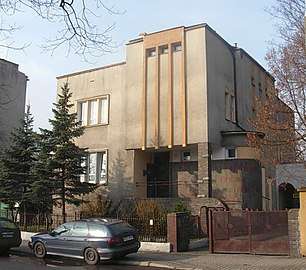 View from the street
View from the street
Villa at No.7
Registered on Kuyavian-Pomeranian Voivodeship heritage list, No.601388, Reg. A/1050, December 31, 1997.[8]
1927-1929 by Bronisław Jankowski
Polish National Style
This large house, (620 m2), was supposed to be a residential building with a lawyer office for a famous family of Polish interwar, the Felcynów[11] In the 1930s, the villa housed the "Headquarters District Command of Border Guard", then, during the nazi occupation, the Westpreussen seat of Selbstschutz of western Prussia. During those dark times, it also housed the Abwehr: the decoration included a series of rooms dedicated for senior military officers (spa and leisure facilities).[11]
After World War II, it was used by NKVD, and between 1947 and 2004, a delegation of Polish Supreme Audit Office used the building. On the facade a plaque by Alexander Dętkoś, unveiled on September 17, commemorates Polish Border Guard personnel murdered by NKVD soldiers during the Katyn massacre.[12]
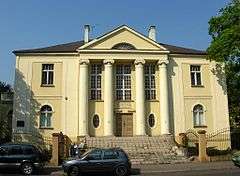 View of the front facade
View of the front facade Side view
Side view Commemorating plaque
Commemorating plaque
Villa at Kopernika Street No.16, corner with Ossoliński Alley
Registered on Kuyavian-Pomeranian Voivodeship heritage list, No.601364, Reg. A/61/1-2, January 20, 2002[8]
1933
The house has been commissioned by Antoni Weynerowski, owner of a successful shoe factory LEO', then KOBRA in the early 20th century, as a wedding gift for his son Witold and his wife Julia. She was from Dutch ascendance, hence the choice of the design, with a de l'Orme roof.[13] After World War II, the villa moved into the hands of the city authorities and became a kindergarten for police members.[13]
 View from street intersection
View from street intersection
 General view with the gable of the garage building on the right
General view with the gable of the garage building on the right
Villa at Kopernika Street No.9, corner with Ossoliński Alley
1932-1933, by Bolesław Polakiewicz[14]
Early modernism, Functionalism
In 1932-1933, Bolesław Polakiewicz realized 9 projects in the area, all characterized by functionalist style: cubic or rectangular forms with enhanced architectural effects.[15]
 View from Kopernika Street
View from Kopernika Street View from Ossoliński Alley
View from Ossoliński Alley General view with Kopernika Street No.9 (center), No.7a (right) and No.16 (left)
General view with Kopernika Street No.9 (center), No.7a (right) and No.16 (left)
Villa at No.23, corner with Asnyka street No.6
1934 by Jan Kossowski
One of the houses part of the Sielanka area project in the 1930s.
 View from Ossoliński Alley
View from Ossoliński Alley
Villa at No.25
1927-1929 by Bronisław Jankowski
Polish National Style
Houses a local branch of a bank.
 Main facade by night
Main facade by night Side view
Side view Side view
Side view
See also
| Wikimedia Commons has media related to Ossoliński Alley in Bydgoszcz. |
- Kopernika Street in Bydgoszcz
- St. Vincent de Paul Basilica Minor in Bydgoszcz
- Pomeranian Philharmonic
- Gdańska Street, Bydgoszcz
- Adam Mickiewicz Alley in Bydgoszcz
- Józef Weyssenhoff Square in Bydgoszcz
- Bydgoszcz
References
- Czachorowski, Antoni (1997). Atlas historyczny miast polskich. Tom II Kujawy. Zeszyt I Bydgoszcz. Toruń: Uniwersytet Mikołaja Kopernik.
- Jastrzębska-Puzowska, Iwona (2005). Od miasteczka do metropolii. Rozwój architektoniczny i urbanistyczny Bydgoszczy w latach 1850-1920. Toruń: Wydawnictwo MADO. ISBN 83-89886-38-3.
- Bydgoszcz Guide. Bydgoszcz: City of Bydgoszcz. July 2014. p. 22. ISBN 83-917786-7-3.
- Kuczma, Rajmund (1995). Zieleń w dawnej Bydgoszczy. Bydgoszcz: Instytut Wydawniczy „Świadectwo”.
- Okoń Emanuel, Tandecki Janusz (1997). Bydgoszcz – historia i rozwój przestrzenny. Atlas historyczny miast polskich. Tom II Kujawy. Zeszyt I Bydgoszcz. Toruń: Uniwersytet Mikołaja Kopernika.
- Umiński, Janusz. Bydgoszcz. Przewodnik. Bydgoszcz: Regionalny Oddział PTTK „Szlak Brdy”. p. 1996.
- Kaja, Renata (1995). Bydgoskie pomniki przyrody. Bydgoszcz: Instytut Wydawniczy „Świadectwo”. ISBN 83-85860-32-0.
- zabytek|kujawsko-pomorskie|issued=1.03.2014
- Wojtonis, Tadeusz (2014). "Historia Parafii". bydgoskabazylika.pl. bydgoskabazylika. Retrieved 12 February 2017.
- Grzybowska Maria, Werterowska Zofia (1999). Przyczynki do historii architektury zespołu naukowych Instytutów Rolniczych w Bydgoszczy. Bydgoszcz: Pracownia Dokumentacji i Popularyzacji Zabytków Wojewódzkiego Ośrodka Kultury w Bydgoszczy. p. 60.
- Kaczmarczyk, Henryk (1996). Budynek przy alei Ossolińskich. Bydgoszcz: Kalendarz Bydgoski. p. 111.
- Umiński, Janusz (2004). Przewodnik, Wydawnictwo Uczelniane Wyższej Pomorskiej Szkoły Turystyki i Hotelarstwa w Bydgoszczy. Bydgoszcz. ISBN 83-914008-7-5.
- Bydgoszcz Guide. Bydgoszcz: City of Bydgoszcz. July 2014. p. 108. ISBN 83-917786-7-3.
- Derkowska - Kostkowska, Bogna (1999). O zalozeniu Sielanki - bydgoskiego miasta ogrodu. Materiały do dziejow kultury i sztuki bydgoszczy T4. Bydgoszcz: Pracownia Dokumentacji i Popularyzacji zabytków Wojewódzkiego osrodja kultury w Bydgoszczy. p. 72.
- Derkowska - Kostkowska, Bogna (1999). O zalozeniu Sielanki - bydgoskiego miasta ogrodu. Materiały do dziejow kultury i sztuki bydgoszczy T4. Bydgoszcz: Pracownia Dokumentacji i Popularyzacji zabytków Wojewódzkiego osrodja kultury w Bydgoszczy. p. 82.
External links
- (in Polish) Official page of Basilica's parish
Bibliography
- (in Polish) Henryk Kaczmarczyk: Budynek przy alei Ossolińskich . Kalendarz Bydgoski 1996
- (in Polish) Czachorowski Antoni red.: Atlas historyczny miast polskich. Tom II Kujawy. Zeszyt I Bydgoszcz. Uniwersytet Mikołaja Kopernika. Toruń 1997
- (in Polish) Jastrzębska-Puzowska, Iwona: Od miasteczka do metropolii. Rozwój architektoniczny i urbanistyczny Bydgoszczy w latach 1850-1920. Wydawnictwo MADO. Toruń 2005. ISBN 83-89886-38-3, 978-83-89886-38-5
- (in Polish) Umiński, Janusz: Bydgoszcz. Przewodnik, Regionalny Oddział PTTK „Szlak Brdy” Bydgoszcz 1996 & "Bydgoszcz – przewodnik"; Bydgoszcz 1996
- (in Polish) Zbigniew Sroka CM – "Bazylika św. Wincentego à Paulo w Bydgoszczy – przewodnik";
- (in Polish) A. Konsek CM, ks. A. Strycharz CM – "Bydgoska Bazylika Mniejsza św. Wincentego à Paulo 1924 – 1999"; Bydgoszcz 1999.




